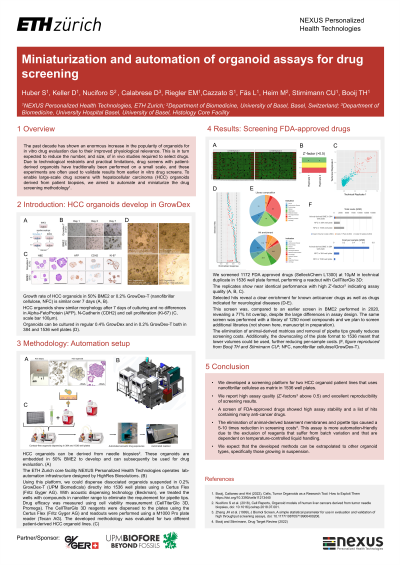Screening Applications & Diagnostics
Poster Session A
(1088-A) Miniaturization and automation of organoid assays for drug screening
Tuesday, May 28, 2024
16:30 - 17:15 CEST
Location: Exhibit Hall

Has Audio
- SH
Stephanie Huber
Assay Development and Screening Specialist
ETH Zurich
Zurich, Zurich, Switzerland
Poster Presenter(s)
Abstract: The past decades have shown an enormous increase in the popularity of using organoids for in vitro drug evaluation due to their improved physiological relevance. This is in turn expected to reduce the number, and size, of in vivo studies required to select effective drugs. Due to technological restraints and practical limitations, drug screens with patient-derived organoids have traditionally been performed on a small scale. To enable large-scale drug screens with HCC organoids derived from patient biopsies, we aimed to miniaturize and automate the drug screening methodology.
Method: The ETH Zurich core facility NEXUS Personalized Health Technologies operates lab-automation infrastructure designed by HighRes Biosolutions. Using this platform, organoids suspended in 0.2% GrowDex-T (UPM Biomedicals) were dispensed directly into 1536 well plates using a Certus Flex (Fritz Gyger AG). Using acoustic dispensing technology (Beckman), test compounds were dispensed in nanoliter range. Drug efficacy was measured using cell viability measurement (CellTiterGlo 3D, Promega). The CellTiterGlo 3D reagents were dispensed to the plates using the Certus Flex (Fritz Gyger AG) and readouts were performed using a M1000 Pro plate reader (Tecan AG). The developed methodology was evaluated for two different patient-derived HCC organoid lines.
Results: The developed methodology was used to screen a library of 1’172 FDA-approved drugs at 10μM in technical duplicates and a panel of 1’250 novel chemicals at 10μM in biological duplicates (performed more than one year apart). For both screens we report high reproducibility and robustness. Furthermore, due to the miniaturization to 1536 well plate format and the elimination of animal-derived matrices, no pipette tips are required at any step in the screening procedure, thereby dramatically reducing the experimental cost and improving assay quality.
Conclusion: A screening platform was developed for HCC that uses patient biopsy-derived organoids in a 1536 well plate format. The developed methodology is automation-compatible and vastly reduces the costs of testing drugs while delivering high-quality and robust screening results.
Method: The ETH Zurich core facility NEXUS Personalized Health Technologies operates lab-automation infrastructure designed by HighRes Biosolutions. Using this platform, organoids suspended in 0.2% GrowDex-T (UPM Biomedicals) were dispensed directly into 1536 well plates using a Certus Flex (Fritz Gyger AG). Using acoustic dispensing technology (Beckman), test compounds were dispensed in nanoliter range. Drug efficacy was measured using cell viability measurement (CellTiterGlo 3D, Promega). The CellTiterGlo 3D reagents were dispensed to the plates using the Certus Flex (Fritz Gyger AG) and readouts were performed using a M1000 Pro plate reader (Tecan AG). The developed methodology was evaluated for two different patient-derived HCC organoid lines.
Results: The developed methodology was used to screen a library of 1’172 FDA-approved drugs at 10μM in technical duplicates and a panel of 1’250 novel chemicals at 10μM in biological duplicates (performed more than one year apart). For both screens we report high reproducibility and robustness. Furthermore, due to the miniaturization to 1536 well plate format and the elimination of animal-derived matrices, no pipette tips are required at any step in the screening procedure, thereby dramatically reducing the experimental cost and improving assay quality.
Conclusion: A screening platform was developed for HCC that uses patient biopsy-derived organoids in a 1536 well plate format. The developed methodology is automation-compatible and vastly reduces the costs of testing drugs while delivering high-quality and robust screening results.
